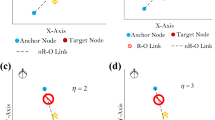Abstract
Minkowski timespace has the capability to overcome the limited accuracy of L2-norm based range-free localization methods. This paper proposes the concept of Minkowski triangulation uncertainty (MTU) in wireless sensor networks (WSNs) for localization of unknown target. To set up a localization framework, triangulation uncertainty parameter is defined using Lemma 3.1. A two-stage estimation algorithm is then presented: countLocalized and countAnchor. countLocalized computes the number of localized sensor nodes by leveraging the uncertainty strategy based upon indeterminate independent measurement. countAnchor designates the anchor nodes to triangulate the unknown target by formulating a convex hull model. The convex hull is the Minkowski sum of the actual and projected positions of the two vector node positions. The proposed MTU technique establishes that the number of triangulations formed by Minkowski method is inclusive of the triangulations formed by conventional L2-norm range of sensor nodes in a WSN. Measurement strategies such as angle, distance and positioning error are compared in the simulation. The said technique links Minkowski space to localization by ensuring efficiency in large target areas and number of nodes in manifolds. Results confirm that the MTU technique is better than the existing models by at least 12%, 50%, 5.5% and 24% in terms of localization ratio, localization error, neighbour anchor nodes and network connectivity, respectively.











Similar content being viewed by others
References
Martini H, Swanepoel KJ, Weiß G (2001) The geometry of Minkowski spaces—a survey. Part I Exp Math 19:97–142. https://doi.org/10.1016/s0723-0869(01)80025-6
Martini H, Swanepoel KJ (2004) The geometry of Minkowski spaces—a survey. Expos Math 22:93–144. https://doi.org/10.1016/S0723-0869(04)80009-4
Böröczky KJ, Matolcsi M, Ruzsa IZ et al (2019) Triangulations and a discrete brunn-minkowski inequality in the plane. Discrete Comput Geom. https://doi.org/10.1007/s00454-019-00131-9
Xu H, Zeng W, Zeng X, Yen GG (2019) An evolutionary algorithm based on Minkowski distance for many-objective optimization. IEEE Trans Cybern 49:3968–3979. https://doi.org/10.1109/TCYB.2018.2856208
Saleem MA, Shamshad S, Ahmed S et al (2021) Security analysis on “a secure three-factor user authentication protocol with forward secrecy for wireless medical sensor network systems.” IEEE Syst J. https://doi.org/10.1109/JSYST.2021.3073537
Han G, Zhang C, Shu L, Rodrigues JJPC (2015) Impacts of deployment strategies on localization performance in underwater acoustic sensor networks. IEEE Trans Ind Electron 62:1725–1733. https://doi.org/10.1109/TIE.2014.2362731
Deshpande N, Grant E, Henderson TC (2014) Target localization and autonomous navigation using wireless sensor networks—a pseudogradient algorithm approach. IEEE Syst J 8:93–103. https://doi.org/10.1109/JSYST.2013.2260631
Sahota H, Kumar R (2018) Maximum-likelihood sensor node localization using received signal strength in multimedia with multipath characteristics. IEEE Syst J 12:506–515. https://doi.org/10.1109/JSYST.2016.2550607
Anwar MA, Siddique AB, Tahir M (2018) Relative self-calibration of wireless acoustic sensor networks using dual positioning mobile beacon. IEEE Syst J 12:862–870. https://doi.org/10.1109/JSYST.2016.2564987
Dutta S, Obaidat MS, Dahal K et al (2019) M-MEMHS: modified minimization of error in multihop system for localization of unknown sensor nodes. IEEE Syst J 13:215–225. https://doi.org/10.1109/JSYST.2018.2868231
Shu F, Yang S, Lu J, Li J (2018) On impact of earth constraint on TDOA-based localization performance in passive multisatellite localization systems. IEEE Syst J 12:3861–3864. https://doi.org/10.1109/JSYST.2017.2778717
Noroozi A, Sebt MA, Oveis AH (2019) Efficient weighted least squares estimator for moving target localization in distributed MIMO radar with location uncertainties. IEEE Syst J 13:4454–4463. https://doi.org/10.1109/JSYST.2019.2896171
Tekdas O, Isler V (2010) Sensor placement for triangulation-based localization. IEEE Trans Autom Sci Eng 7:681–685. https://doi.org/10.1109/TASE.2009.2037135
Shamshad S, Mahmood K, Kumari S (2020) Comments on “a multi-factor user authentication and key agreement protocol based on bilinear pairing for the internet of things.” Wirel Pers Commun 112:463–466. https://doi.org/10.1007/s11277-020-07038-2
El Korso MN, Boyer R, Renaux A, Marcos S (2010) Statistical resolution limit for multiple parameters of interest and for multiple signals. In: 2010 IEEE International Conference on Acoustics, Speech and Signal Processing. IEEE, pp 3602–3605
Khaldi B, Harrou F, Cherif F, Sun Y (2019) Flexible and efficient topological approaches for a reliable robots swarm aggregation. IEEE Access 7:96372–96383. https://doi.org/10.1109/ACCESS.2019.2930677
Lim TJ, Franceschetti M (2017) Completely blind sensing of multi-band signals. In: 2017 IEEE International Symposium on Information Theory (ISIT). IEEE, pp 1331–1335
Ajgl J, Straka O (2017) A geometrical perspective on fusion under unknown correlations based on Minkowski sums. In: 2017 20th International Conference on Information Fusion (Fusion). IEEE, pp 1–8
Shi D, Chen T, Shi L (2015) On set-valued Kalman filtering and its application to event-based state estimation. IEEE Trans Automat Control 60:1275–1290. https://doi.org/10.1109/TAC.2014.2370472
Shamshad S, Ayub MF, Mahmood K et al (2021) An enhanced scheme for mutual authentication for healthcare services. Digit Commun Netw. https://doi.org/10.1016/j.dcan.2021.07.002
Yunyun Z, Xiangke W, Weiwei K, Lincheng S (2017) Information fusion analysis of multi-UAV system based on information geometry. In: 2017 36th Chinese Control Conference (CCC). IEEE, pp 8491–8496
Prateek AR (2021) C-TOL: convex triangulation for optimal node localization with weighted uncertainties. Phys Commun 46:101300. https://doi.org/10.1016/j.phycom.2021.101300
Ding K, Yousefi’zadeh H, Jabbari F (2018) A robust advantaged node placement strategy for sparse network graphs. IEEE Trans Netw Sci Eng 5:113–126. https://doi.org/10.1109/TNSE.2017.2734111
Mridula KM, Rahman N, Ameer PM (2019) Sound velocity profile estimation using ray tracing and nature inspired meta-heuristic algorithms in underwater sensor networks. IET Commun 13:528–538. https://doi.org/10.1049/iet-com.2018.5106
Prateek AR, Verma AK (2021) Non-coherent localization with geometric topology of wireless sensor network under target and anchor node perturbations. Wirel Netw 27:2271–2286. https://doi.org/10.1007/s11276-021-02575-5
Schröter J (2017) Minkowski space—the spacetime of special relativity
Acknowledgements
There is no acknowledgment.
Author information
Authors and Affiliations
Corresponding author
Additional information
Publisher's Note
Springer Nature remains neutral with regard to jurisdictional claims in published maps and institutional affiliations.
Rights and permissions
About this article
Cite this article
Prateek, Arya, R. Range free localization technique under erroneous estimation in wireless sensor networks. J Supercomput 78, 5050–5074 (2022). https://doi.org/10.1007/s11227-021-04075-x
Accepted:
Published:
Issue Date:
DOI: https://doi.org/10.1007/s11227-021-04075-x




